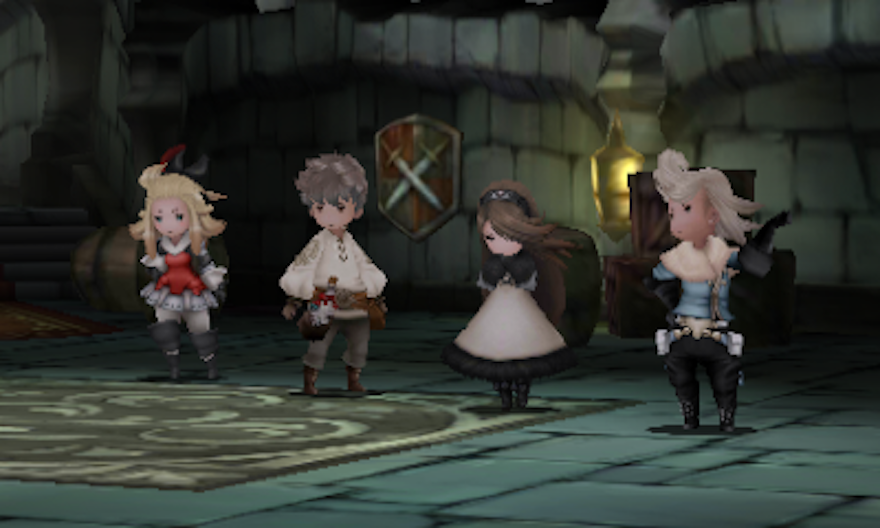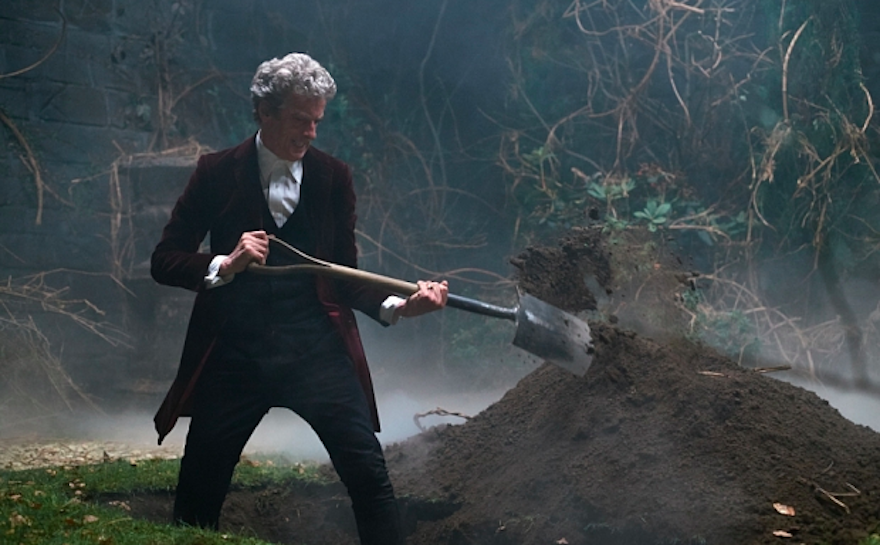If I started this article at the end it probably wouldn’t make much sense. There’s a reason most writers put words and events in chronological order to tell a story. Some stories, however, are best told out of order.
Charlie Kaufman’s Eternal Sunshine of the Spotless Mind (2004) works this way as it uses the chaotic scrambling of the nonlinear narrative to explore the limits of human memory. So too does a recent episode of Doctor Who, “Heaven Sent” (2015), which uses a repeated narrative to highlight the stubbornness and fortitude of the Doctor’s character. For videogames, taking these same non-typical approaches to narrative as film and television can be much more difficult. This is due to games having to worry about player interactions in a way other forms of media do not. Bravely Default, the 2012 Nintendo 3DS title by Square Enix, tells its story using both a nonlinear and repeated narrative to increase the intensity and scale of the story far beyond the hours spent playing it.
In Bravely Default, the opening of The Great Chasm—a giant, cataclysmic event—swallows up the hometown of one of the main characters, Tiz. He then sets out to try to find a way to right the world that is now being attacked by darkness. It’s a typical start, for what ends up being a very non-typical story. Tiz meets up with Agnes, the Vestal of Wind, who is part of the Crystal Orthodoxy that worships four crystals that protect the land. These four crystals have since fallen into darkness. Tiz and Agnes also join up with three others: Airy, a crystal fairy who gives the group direction and guidance; Ringabell, a womanizer with no memory of his past; and Edea, the daughter of the head of the Anti-Crystalism movement who is out to right the wrongs of her father.

Bravely Default unfolds over the next 40-50 hours, a lengthy story by any means, as Tiz and company try to figure out what is causing the Crystals to go dark, and how they can stop it. However, when trying to play with narrative form, Bravely Default highlights both the benefits, and drawbacks that games can face when using these atypical types of narrative. After freeing all of the crystals, the group is transported to a parallel world nearly identical to their original one, the same events repeating. Everyone decides to free the crystals again in this world as well, and then the next four chapters of the game are spent re-fighting the same bosses and freeing the same crystals, over and over and over again. There are slight changes in each world, but most of the events are the same as the player travels from one parallel world to the next. It’s as exhausting as it sounds.
This repetition of these same (or parallel) events is comparable to the narrative form used in the Doctor Who “Heaven Sent” episode, in which the Doctor is stuck in a castle surrounded by puzzles and being chased by a deathly creature. The Doctor eventually realizes that the castle is a trap created to get him to confess his deepest secrets, and soon learns that the skulls surrounding the castle are none other than his own, collected over the many years he has lived through the same scenarios in the castle—each time he uses his dying energy to create a new copy of himself to continue trying to escape. The Doctor then spends four billion years slowly working his way through a wall in the prison, until he finally breaks through and makes his way out. Having the Doctor live through these events only a few times wouldn’t carry the same weight, nor would it say the same about his character, as it does having him spend four billion years working in the prison. Once the Doctor realizes that he is stuck in a loop of the same events, however, the episode doesn’t make the viewer watch the same events over and over again. Instead, it truncates them and cuts them into a montage of short clips.
Bravely Default decides not to make use of the same devices in its repeated narrative. Due to its time-limited format, the TV episode uses increasingly shorter scenes to imply the repeated scenes, showing the same events with a few of the minor details changed each time. Bravely Default, instead, has the player actually re-live in full the actions, puzzles, and fights each and every time. It isn’t just telling or showing a story, it’s inviting the player to live through the repeated events the same way the characters are in the story. Due to the graces of length and time that videogames (especially RPGs) are given, Bravely Default is able to have the player live out this grueling, analogous act. By doing this, players are pushed closer to experiencing the gravity of the situation these characters live through, repeating each leg of that journey, step-by-step without much respite. If the game simply showed a cutscene of the events happening over and over, the player would never feel frustrated, and it’s important that this genuine feeling is baked into them for the story to be at its most impacting. The repetition is meant to make the player hope, with each cycle, that it’ll be the last time they’ll have to save the crystals. It’s the same hope the characters feel. And it’s the same feeling of being let down when they realize they have to start over once again. This is a big risk for the game’s creators to take but, presuming the player goes through with it, by the end they should be in tune, almost as one, with the characters’ mindsets.
Slowly, over the course of linking all these worlds, doubt starts to sink into all the characters’ heads as they fail to save the world time and again. When it’s revealed that Airy—the fairy traveling with them—was actually using them to link millions of worlds together in order to revive Ouroboros, the god of destruction, it’s not that big of a surprise. But it does turn the RPG trope of magical guides that never steer adventures wrong (here’s looking at you, Navi) on its head. It also makes the repetition of the last few chapters sting even more. Not only have the characters been stuck in the same chain of events, but their actions have been making things worse; the exact opposite of what they had hoped. All that work was not for nothing after all—but they may wish that it was—instead it actively progressed the opposing agenda and further plunged the worlds into darkness.

But the repetition of the narrative does more than breed frustration. It also adds multiple layers and both a timely and emotional investment to the quest, as well. The severity of the situation and the fact that all of these worlds now hang in the balance of the player’s actions is only conveyed as lucidly as it is due to the time and effort they had to put in to get there. The game doesn’t just tell players that a bunch of worlds are linked together… they actually had to create these connections themselves across hours and hours of play. They are to blame—sure, they were tricked—but their actions directly caused the events that are unfolding. The player created this mess, and multitudes of worlds are now on the brink of destruction because of it. They can’t escape that fact nor the hours they spent making it happen.
Repetitive narrative isn’t the only structural storytelling device that Bravely Default experiments with. The dimension that players start out Bravely Default in is, at the end, revealed not to be the dimension where the story started. Ringabell is ultimately revealed to be Alternis, the Dark Knight from the first world, who traveled into the second parallel world where he meets up with the playable characters and the story as we know it starts. His flashbacks of failing in the first dimension reveal his character motivation, and how much he deeply cares about helping save the world(s). His failure in the first world sets the entire story into motion. Compare this to the film Eternal Sunshine of the Spotless Mind, where the first time the viewers meet the main characters is not the first time the characters themselves have met. The reason for doing this is to have the viewer confronted with a later revelation that encourages them to muse on the film’s themes of love and memory.
In Bravely Default, keeping Ringabell’s roots in another world hidden for so long achieves something similar to Eternal Sunshine of the Spotless Mind. Throughout the story, Ringabell is mostly used for comedic effect. But when it’s revealed that he’s trying to atone for being unable to save the first world, the story is graced with the added theme of redemption. Ringabell’s character—up to this point—has mostly been defined by his indefatigable attraction toward the women around him, including Agnes and Edea. But by giving this love roots in his initial failure, not just in his pants, it shifts the player’s view of the character. It’s made clear that no longer is Ringabell simply driven by physical attraction, but that he’s being driven by a need to make up for his past. Non-linearity is key here: if the player (and by extension, the characters) knew who Ringabell truly was from the start, the initial trust of him could have never been developed. Giving him this extra layer of self-redemption makes the character far from the one-dimensional and sex-crazed boy he initially seemed. Even the person playing as the group’s comic relief gets to play the part of hero.
By starting the story in a second world, after the first has failed, Bravely Default is also able to give the end-game real stakes. Other versions of these characters have taken up the same task in other worlds, and died trying. In the final fight with Ouroborus, he’ll start to destroy entire worlds both the ones the player has linked, and those that are populated by other real-world players they’ve met with the 3DS’ StreetPass feature. This adds another level of reality—a further gravitas—to the many fictional layers already stacked upon Bravely Default’s worlds. The game wants the player to feel the weight of the destruction they’ve enabled as if there was blood dripping from their hands. It isn’t just the fate of one world but all of the myriad parallel worlds that hangs in the balance. And most of all, it’s made the player live in those alternate worlds, it’s made those places tangible, part of the characters’ memories, they feel real, and now they have to witness their annihilation, or attempt to be their salvation.
